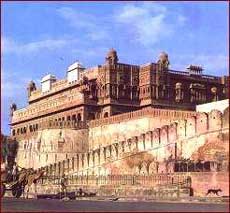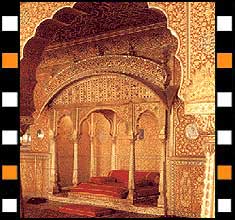Friday, April 25, 2014
Wednesday, September 27, 2006
Bikaner....
Tourism Attractions
Junagarh Fort
This fort was built by Raja Rai Singhji, the sixth ruler of Bikaner, who ruled form 1571 to 1612. Raja Rai Singhji could Marshal the revenues of a kingdom increased by the conquest of half Marwar and grant of half Gujrat and made use of ample funds from Jodhpur and Western Deccan for the construction of this fort. A contemporary of Mughal Emperor Akbar and Emperor Jehangir, he held a very high rank in the Imperial court. As a reward for this services as military commander, he was granted fields of Gujrat and Burhanpur by the Emperor. During his tenure in imperial service he traveled far and wide which gave him vision and great ideas about art and architecture and we can see how meticulously these ideas were incorporated in the architectural styles of his building in Junagarh fort.
Lalgarh Palace


The architectural masterpiece in red sandstone was built by Maharaja Ganga Singh (1881-1942) in memory of his father Maharaja Lall Singh between 1902 and 1926. This magnificent palace is an example of pure Rajput martial architecture. Designed by Sir Swinton Jacob, this palace has several grand halls, lounges, cupolas and pavilions. The exotic palace has magnificent pillars, richly carved fire mantles, Italian colonnades and motif of lotus in full bloom, adding to the magic of this jewel of the desert. Walls of palaces are reminiscent of the past vintage etchings, hunting trophies and old portraits. The treasure trove where the guests can spend hours 'walking in the past'. The palace has its own museum and library (the fourth largest in the world), clay pigeon trap and skeet shooting traps facilities at adjoining ranges. Palace has wild peacocks spreading their feathers at almost every step flowering rows of bougainvillea. Bikaner royal family still lives in part of the palace. A portion of palace is now a hotel. Demographics
As of 2001 India census GRIndia, Bikaner had a population of 529,007. Males constitute 53% of the population and females 47%. Bikaner has an average literacy rate of 66%, higher than the national average of 59.5%; with male literacy of 74% and female literacy of 57%. 14% of the population is under 6 years of age.
The Har Mandir
This is the majestic chapel for the royal family for worshipping their gods and goddesses.
Bhandeshwar Jain Temples

Bikaner boasts of some beautiful Jain temples, belonging to the 16th century. Include the Lakshminathji, Ratan Biharji, Shiv Bari and Nagnechiji temple are the other important shrines of Bikaner.
Culture
Bikaner is famous for its "Bikaneri Bhujia" and sweets. Bikaneri Bhujia is a spicy snack made from moth dal, spices and edible oil. Other famous things of thar land Bikaner are its craft work, its camel farm which is the biggest camel farm of Asia, leather articles and palaces. Every year in the month of January state government organises a camel festival with camel races, various cultural events and importantly fire dance by the Sidh people. Fire dance and Sidh Sidh people who dance on fire bare feet are followers of Sant Jasnath Ji(A.D. 1482-1506). For years they have been regarded as the Jasnathi Samparday of Jat community and also the Jasnathi Jat. Their origin place is Katariasar village, situated 45 km away from Bikaner in remote area where Sant Jasnath Ji had meditation. A group of 12 to 15 persons dance on burning fire with music and drums take maximum 45 minutes. Before beginning their performance, they take one hour for meditation. Sidh's are purely vegitarian, found mostely in Rajasthan. Sidh and Ecoethics The founder of the Bishnoi sect was not alone in attempting to influence conduct towards living beings via religious and ethical transformation. Another popular saint, Jasnathji (A.D. 1482-1506), a contemporary of Jambhoji, also endorsed such a viewpoint. His followers were known as Jasnathi. Like his contemporary, Jasnathji was also aware of the importance of the preservation of the environment. In his teachings, the jal tree, which formed the natural vegetation of the region, was accorded special protection (Pemaram 1977). These teachings became popular in the region, which had traditionally sustained goat and sheep rearing. Conservation of green vegetation and ban on the slaughter of animals seemed to be an attempt towards protecting people’s livelihoods. Restrictions through religious and official sanctions question the older assumptions of prudent use of natural resources and environmental conservation as supposedly practised by traditional societies. Pemaram. 1977. The Religious Movements in Medieval Rajasthan. Archana Prakashan, Ajmer. Conservation and Society, Volume 3, No. 1, June 2005, Pages 134 - 149 The Harsh community is also very popular in Bikaner.
Fiesta Time
» Camel Festival: The camel festival ensures a memorable experience. In the month of January one witnesses a spectacle of unusual camel performances - camel races, camel dances, and the camel rides.
» Karni Mata Fair: The fair is held twice a year - April / May, October / November for the devotees of the Goddess Durga.
» Kolayatji fair: Held in October-November at Kolayat, devotees consider it auspious to take a holy dip in the Kolayat Lake and offer prayers to Karni Mata.
Shopper's Stop
Bikaner is the ideal place to buy articles made of camel-hide, camel and sheep wool carpets and woollen items, wood and leather products. While some food items like sweets and snacks can also be bought from here.
How to Reach
» Air: The nearest airport is Jodhpur 253 km.
» Rail: Bikaner is connected with Delhi, Jaipur, Jodhpur, Bhatinda, Kalka and Howarh (Culcutta). » Road: Bikaner is connected by road with the major cities of India. Some important distance are : Delhi 456 km, Jaipur 334 km, Jaisalmer 333 km.
Junagarh Fort
This fort was built by Raja Rai Singhji, the sixth ruler of Bikaner, who ruled form 1571 to 1612. Raja Rai Singhji could Marshal the revenues of a kingdom increased by the conquest of half Marwar and grant of half Gujrat and made use of ample funds from Jodhpur and Western Deccan for the construction of this fort. A contemporary of Mughal Emperor Akbar and Emperor Jehangir, he held a very high rank in the Imperial court. As a reward for this services as military commander, he was granted fields of Gujrat and Burhanpur by the Emperor. During his tenure in imperial service he traveled far and wide which gave him vision and great ideas about art and architecture and we can see how meticulously these ideas were incorporated in the architectural styles of his building in Junagarh fort.
Lalgarh Palace


The architectural masterpiece in red sandstone was built by Maharaja Ganga Singh (1881-1942) in memory of his father Maharaja Lall Singh between 1902 and 1926. This magnificent palace is an example of pure Rajput martial architecture. Designed by Sir Swinton Jacob, this palace has several grand halls, lounges, cupolas and pavilions. The exotic palace has magnificent pillars, richly carved fire mantles, Italian colonnades and motif of lotus in full bloom, adding to the magic of this jewel of the desert. Walls of palaces are reminiscent of the past vintage etchings, hunting trophies and old portraits. The treasure trove where the guests can spend hours 'walking in the past'. The palace has its own museum and library (the fourth largest in the world), clay pigeon trap and skeet shooting traps facilities at adjoining ranges. Palace has wild peacocks spreading their feathers at almost every step flowering rows of bougainvillea. Bikaner royal family still lives in part of the palace. A portion of palace is now a hotel. Demographics
As of 2001 India census GRIndia, Bikaner had a population of 529,007. Males constitute 53% of the population and females 47%. Bikaner has an average literacy rate of 66%, higher than the national average of 59.5%; with male literacy of 74% and female literacy of 57%. 14% of the population is under 6 years of age.
The Har Mandir
This is the majestic chapel for the royal family for worshipping their gods and goddesses.
Bhandeshwar Jain Temples

Bikaner boasts of some beautiful Jain temples, belonging to the 16th century. Include the Lakshminathji, Ratan Biharji, Shiv Bari and Nagnechiji temple are the other important shrines of Bikaner.
Culture
Bikaner is famous for its "Bikaneri Bhujia" and sweets. Bikaneri Bhujia is a spicy snack made from moth dal, spices and edible oil. Other famous things of thar land Bikaner are its craft work, its camel farm which is the biggest camel farm of Asia, leather articles and palaces. Every year in the month of January state government organises a camel festival with camel races, various cultural events and importantly fire dance by the Sidh people. Fire dance and Sidh Sidh people who dance on fire bare feet are followers of Sant Jasnath Ji(A.D. 1482-1506). For years they have been regarded as the Jasnathi Samparday of Jat community and also the Jasnathi Jat. Their origin place is Katariasar village, situated 45 km away from Bikaner in remote area where Sant Jasnath Ji had meditation. A group of 12 to 15 persons dance on burning fire with music and drums take maximum 45 minutes. Before beginning their performance, they take one hour for meditation. Sidh's are purely vegitarian, found mostely in Rajasthan. Sidh and Ecoethics The founder of the Bishnoi sect was not alone in attempting to influence conduct towards living beings via religious and ethical transformation. Another popular saint, Jasnathji (A.D. 1482-1506), a contemporary of Jambhoji, also endorsed such a viewpoint. His followers were known as Jasnathi. Like his contemporary, Jasnathji was also aware of the importance of the preservation of the environment. In his teachings, the jal tree, which formed the natural vegetation of the region, was accorded special protection (Pemaram 1977). These teachings became popular in the region, which had traditionally sustained goat and sheep rearing. Conservation of green vegetation and ban on the slaughter of animals seemed to be an attempt towards protecting people’s livelihoods. Restrictions through religious and official sanctions question the older assumptions of prudent use of natural resources and environmental conservation as supposedly practised by traditional societies. Pemaram. 1977. The Religious Movements in Medieval Rajasthan. Archana Prakashan, Ajmer. Conservation and Society, Volume 3, No. 1, June 2005, Pages 134 - 149 The Harsh community is also very popular in Bikaner.
Fiesta Time
» Camel Festival: The camel festival ensures a memorable experience. In the month of January one witnesses a spectacle of unusual camel performances - camel races, camel dances, and the camel rides.
» Karni Mata Fair: The fair is held twice a year - April / May, October / November for the devotees of the Goddess Durga.
» Kolayatji fair: Held in October-November at Kolayat, devotees consider it auspious to take a holy dip in the Kolayat Lake and offer prayers to Karni Mata.
Shopper's Stop
Bikaner is the ideal place to buy articles made of camel-hide, camel and sheep wool carpets and woollen items, wood and leather products. While some food items like sweets and snacks can also be bought from here.
How to Reach
» Air: The nearest airport is Jodhpur 253 km.
» Rail: Bikaner is connected with Delhi, Jaipur, Jodhpur, Bhatinda, Kalka and Howarh (Culcutta). » Road: Bikaner is connected by road with the major cities of India. Some important distance are : Delhi 456 km, Jaipur 334 km, Jaisalmer 333 km.
Tuesday, September 26, 2006
Hello Bikaner walo
Hello readers,
Accept my greetings, all Bikanerwalas. This blog is exclusively for Bikaner, people of Bikaner, products of Bikaner, festivals, rituals, the golden sand, the dancing kites, each and everything thing that u name about bikaner.
This is the first post, I hope you all will help making our Bikaner - "Aapno Bikano, Niralo Bikano" more famous.
Thanks,
Vijay Agarwal(Viz).
Accept my greetings, all Bikanerwalas. This blog is exclusively for Bikaner, people of Bikaner, products of Bikaner, festivals, rituals, the golden sand, the dancing kites, each and everything thing that u name about bikaner.
This is the first post, I hope you all will help making our Bikaner - "Aapno Bikano, Niralo Bikano" more famous.
Thanks,
Vijay Agarwal(Viz).
Bikaner...an introduction...a brief History
 Introduction
IntroductionHi,
Well, what should i do first, introduce myself or introdue you all to my city, Bikaner, which is world famous for various things, various rituals, various places.
Well however let me introduce myself. I'm Vijay Agarwal, and i love my city, Bikaner a lot.
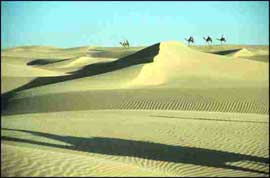
Have you ever been to Bikaner?
NO?
Ok never mind. I will try to make you feel Bikaner to whoever haven't came here yet. And that will make you come here.
Brief History
Bikaner is the second largest city(area wise) situated at the western part of the state and nort-western part of India and share a side of border with Pakistan.
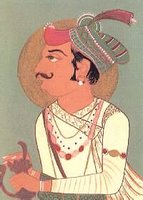 It was formerly the capital of the princely state of Bikaner. The Bikaner city was founded by Rao Bikaji Rathore, son of Rao Jodhaji of Marwar (Jodhpur), founded the state of Bikaner, in Northern Rajasthan, in 1465 under guardianship of his uncle Rao Kandhal and it progressed from small place to big city of the western desert. The Gang canal, and the Indira Gandhi Canal has changed the area. The city has diversified industrially.
It was formerly the capital of the princely state of Bikaner. The Bikaner city was founded by Rao Bikaji Rathore, son of Rao Jodhaji of Marwar (Jodhpur), founded the state of Bikaner, in Northern Rajasthan, in 1465 under guardianship of his uncle Rao Kandhal and it progressed from small place to big city of the western desert. The Gang canal, and the Indira Gandhi Canal has changed the area. The city has diversified industrially.One of the most famous landmarks of Bikaner is Deshnokh Temple, a world famous temple where rats roam around freely, and spotting a white rat is considered lucky.
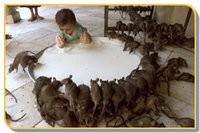
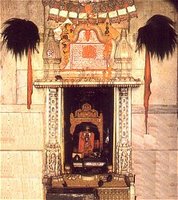

Bikaner is the largest wool market of Asia i.e. wool production, carpet industry, and many other woolen products. Minerals like gypsum, plaster of Paris, lignite, and bentonite are few minerals found in abundant around Bikaner.
Subscribe to:
Comments (Atom)
